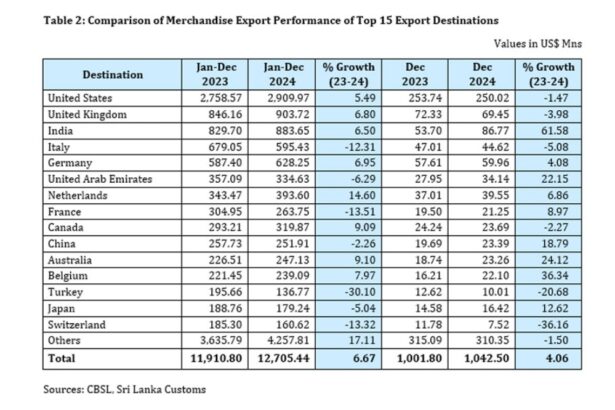Sri Lanka’s apparel industry is facing a significant blow following the imposition of a 44% tariff on Sri Lankan goods by the United States under President Donald Trump’s revised trade policy.
The move, described by the U.S. as a reciprocal measure in response to what it claims are Sri Lanka’s 88% trade barriers on American goods, places Sri Lanka among the countries facing the highest tariff rates globally.
The United States has long been Sri Lanka’s most important export destination, accounting for 23% of total merchandise exports in 2024. Of nearly 3 billion in exports to the U.S. last year, the vast majority—over 70%—came from the apparel sector. These include men’s and women’s undergarments, outerwear, T-shirts, sportswear, gloves, and baby garments.
Industry leaders and economic analysts warn that the steep tariff could have serious consequences for Sri Lanka’s already fragile economy. With the new 44% levy, Sri Lankan garments risk becoming uncompetitive in the U.S. market, which could result in a sharp drop in orders. This would lead to a contraction in apparel export earnings and threaten thousands of jobs in one of Sri Lanka’s most vital sectors.
Exporters fear U.S. orders could plummet in volume as Sri Lankan-made apparel becomes dramatically more expensive for American importers. A tariff of this magnitude effectively adds nearly half again to the cost of Sri Lankan goods entering the U.S. market. For price-sensitive retailers and consumers, such a jump is likely to suppress demand
The apparel industry is Sri Lanka’s largest industrial export sector, employing nearly 300,000 people directly and supporting hundreds of thousands more through indirect employment. Companies like MAS Holdings, Brandix, and Hirdaramani—major players in the global garment supply chain—are likely to face pressure on profit margins. Smaller and medium-sized exporters, many of whom rely heavily on U.S. buyers, are particularly vulnerable and may be forced to reduce production or shut down altogether.
Notably, Sri Lanka is not alone in facing U.S. tariffs – other major apparel exporters like Bangladesh (37% tariff), Vietnam (46%), India (26%), and Cambodia (49%) were also hit with hefty duties
This across-the-board hike means U.S. buyers cannot entirely avoid higher costs by simply switching to another Asian supplier. However, Sri Lanka’s rate is among the highest, putting it at a slight disadvantage relative to some peers (for example, Bangladesh’s tariff is lower).
The Joint Apparel Association Forum (JAAF), the leading industry body, is expected to coordinate with the government to seek urgent relief.
Foreign Affairs Minister Vijitha Herath last month announced that a high-level Sri Lankan delegation will travel to Washington, D.C. in May for talks with U.S. trade officials, with the aim of mitigating or lifting the tariffs
“Sri Lanka simply cannot afford the burden of these additional tariffs on our exports,” Herath told Parliament, stressing the country’s fragile economic state after its recent financial crisis
Sri Lanka is currently under an IMF-supported reform program, and the minister expressed optimism that this could bolster their case for relief or a waiver from the U.S.
The government is expected to highlight the potential humanitarian impact – including job losses and reduced income for a developing nation – in its appeal to the U.S., arguing that Sri Lanka’s high import tariffs (the source of Trump’s “reciprocal” argument) are already being phased down as part of economic reforms.
The new tariff comes at a critical time for Sri Lanka, as it emerges from an economic crisis marked by inflation, debt restructuring, and a steep decline in foreign reserves. The apparel industry had shown signs of recovery, with modest growth in exports and renewed interest from international buyers. The sudden imposition of the U.S. tariff threatens to reverse those gains.
With global trade tensions rising, Sri Lanka’s apparel sector now finds itself navigating a period of unprecedented uncertainty. The government’s ability to negotiate exemptions or reduced tariffs, and the industry’s adaptability in the face of rising trade barriers, will be crucial in determining how deeply the sector is affected in the months ahead. (NewsWire)
The post Trump’s 44% US Tariff: How it will affect Sri Lanka ? appeared first on Newswire.




